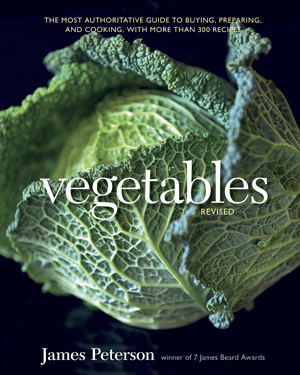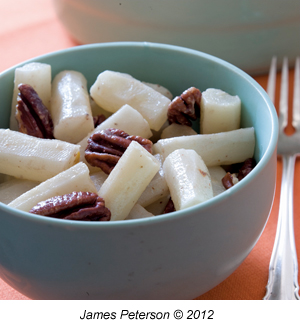Share This
The summer months offer a tantalizing variety of fresh vegetables, picked straight from your garden, or available at local farmers markets and supermarkets. There is no doubt that summer is the ideal time to experiment with new plant-based ingredients and preparations. But it’s easy to become overwhelmed with the sheer number of options. Take heart! Vegetables Revised, James Peterson’s newest book, is the perfect tool to alleviate any anxiety. Vegetables Revised is touted as the “Most authoritative guide to buying, preparing, and cooking vegetables.” With tips on techniques and how-to’s, 300 recipes, and a vegetable glossary to boot, this book gives all the answers.
We caught up with James to gather some great insights into the world of vegetables.
OLDWAYS: For those who may not be familiar with your work – from your decades of teaching to your seven James Beard Awards – can you tell us a bit about yourself and how you came to write about vegetables?
JAMES: When I returned to the United States after living in France, I opened a restaurant in New York which was open for four years. During that time I was able to perfect my skills and practice on the public. When I started writing books, I soon gravitated to vegetables because they have such a diversity of flavor. For example, how many meats do we have access to in this modern age? Lamb, beef, veal, pork, chicken, rabbit, and that’s about it. There is also a similarity in the flavor of meats and seafood that doesn’t occur in the vegetable kingdom. Every vegetable is different in a distinctive way.
I first decided to write a book about vegetables when I saw that even my cooking friends didn’t quite know what they were doing. Every vegetable has its own idiosyncrasies and particular identity and has to be cooked using very specific methods. Boil a carrot for example and you’re guaranteed that it will have no flavor. Steam zucchini and you’ll end up with mush. So I decided to elucidate the simplest techniques first and explain the characteristics of the vegetables and how best to cook them. More elaborate recipes are only introduced after the simplest techniques have been explained.
OLDWAYS: How does this edition differ from the original Vegetables, published in 1998?
JAMES: New vegetables have been added. The book has been entirely reorganized so that all the vegetables can be accessed in an easy dictionary format, unlike the earlier edition, which was more organized by technique. In addition, of course, it now has full-color photography throughout. The book now bears witness to a year of picking the best produce from the green market and following the seasons from March’s morels and asparagus to the winter squash that appears in the fall.
OLDWAYS: With all the techniques, information, and recipes your book offers, you still encourage readers to experiment. Straying from a recipe might be scary for beginning cooks. What are the easiest ways for someone to break away from a recipe to make it their own?
JAMES: I emphasize technique. Once the vegetable is understood—it’s character and idiosyncrasies have been explained—it’s a simple matter to derive the best technique. Virtually any ingredient can be used provided we know the best technique for cooking it. Once the basic properties of the vegetable are understood, it’s a natural thing to pair it with other ingredients. I explain, for example, how to finish sautéed vegetables with herb butters, how to glaze root vegetables in various fats, how to use both dried and fresh herbs.
OLDWAYS: You include a section devoted to herbs. Helping people to better understand how herbs enhance foods is music to our ears! What mistakes do you think beginners make when they first start using herbs?
JAMES: It helps to divide herbs into two families—oil-based and water-based. Water-based herbs include such things as chives, tarragon, basil, chervil, parsley, and cilantro. Oil-based herbs include thyme, bay leaf, rosemary, marjoram, oregano, savory and others. Water-based herbs do not dry well but they can be infused in oil or vinegar to preserve them. Tarragon is especially good when preserved in wine vinegar; basil, however is awful. Water-based herbs should be chopped at the last minute (otherwise they loose flavor; some turn black) and added to foods just before serving so their flavor has no time to cook off. Oil-based herbs dry well and can be added to long-cooked dishes early in the game since they release their flavor slowly. They are wonderful—and it’s hard to go wrong—sprinkled on vegetables during sautéing.
OLDWAYS: What techniques tend to be overlooked but make for very successful and delicious vegetable dishes?
JAMES: I don’t think it’s so much that techniques get overlooked in general, but rather that the wrong technique is used for the wrong vegetable. As I said earlier, boiling carrots or other sweet root vegetables just leaches out their natural sugars. Steaming watery vegetables is catastrophic as is boiling.
OLDWAYS: We know you must have discovered some great tricks of the trade that made you think, “Oh my gosh, how did I ever live without knowing this?!” Can you share one or two of your favorite tips with our readers?
JAMES: One of my little tricks is to add olive oil to bottled mayonnaise to improvise a quick “homemade” mayonnaise. Another, more sophisticated discovery, was the use of lobster roe, strained raw through a chinoise and then whisked up into a bright red sauce just before serving.
OLDWAYS: We would kick ourselves if we missed this opportunity. Can you give us permission to include one of your Vegetables Revised recipes in this blog post and on our website?
JAMES: I, of course, would be honored if you used a recipe or two or more!
Reprint with permission from Vegetables by James Peterson, copyright©2012. Published by Ten Speed Press, a division of Random House, Inc.
Salsify and Pecan Salad
This simple little salad provides a good way to appreciate salsify, especially if you’re cooking it for the first time. The salsify is peeled, simmered in water with lemon juice in it, and then tossed with vinaigrette. Toasted pecans are included to provide contrasting texture and flavor.
Makes 4 Side-dish Servings
Ingredients:
½ cup pecans
10 salsify roots
1 lemon
1 teaspoon Dijon mustard
2 teaspoons sherry vinegar
2 tablespoons canola or pure olive oil
Salt and freshly ground black pepper
Directions:
Preheat the oven to 350°F.
Spread out the pecans in a shallow baking pan and toast for 15 minutes, or until fragrant.
Peel the salsify and rub each root with a half a lemon. Cut the salsify into 2- to 3-inch pieces. Squeeze the lemon halves into 4 quarts of salted water (don’t add the whole halves or the salsify will taste like lemon furniture polish) in a large pot. Add the salsify and simmer until the salsify can be penetrated with a knife, but still offers some resistance (about the same as a perfectly cooked artichoke), about 20 minutes. Drain and let cool.
Whisk together the mustard and vinegar and then whisk in the oil. Toss with the salsify, the nuts, and the salt and pepper. If you’re not serving right away, don’t add the nuts until the last minute or they’ll get soggy.




Add a Comment